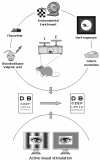New perspectives in amblyopia therapy on adults: a critical role for the excitatory/inhibitory balance
- PMID: 22144947
- PMCID: PMC3223381
- DOI: 10.3389/fncel.2011.00025
New perspectives in amblyopia therapy on adults: a critical role for the excitatory/inhibitory balance
Abstract
Amblyopia is the most common form of impairment of visual function affecting one eye, with a prevalence of about 1-5% of the total world population. This pathology is caused by early abnormal visual experience with a functional imbalance between the two eyes owing to anisometropia, strabismus, or congenital cataract, resulting in a dramatic loss of visual acuity in an apparently healthy eye and various other perceptual abnormalities, including deficits in contrast sensitivity and in stereopsis. It is currently accepted that, due to a lack of sufficient plasticity within the brain, amblyopia is untreatable in adulthood. However, recent results obtained both in clinical trials and in animal models have challenged this traditional view, unmasking a previously unsuspected potential for promoting recovery after the end of the critical period for visual cortex plasticity. These studies point toward the intracortical inhibitory transmission as a crucial brake for therapeutic rehabilitation and recovery from amblyopia in the adult brain.
Keywords: GABAergic inhibition; amblyopia; environmental enrichment; fluoxetine; neural plasticity; perceptual learning.
Figures

Similar articles
-
Treatment of amblyopia in the adult: insights from a new rodent model of visual perceptual learning.Front Neural Circuits. 2014 Jul 16;8:82. doi: 10.3389/fncir.2014.00082. eCollection 2014. Front Neural Circuits. 2014. PMID: 25076874 Free PMC article. Review.
-
Active training for amblyopia in adult rodents.Front Behav Neurosci. 2015 Oct 27;9:281. doi: 10.3389/fnbeh.2015.00281. eCollection 2015. Front Behav Neurosci. 2015. PMID: 26578911 Free PMC article. Review.
-
Enriched experience and recovery from amblyopia in adult rats: impact of motor, social and sensory components.Neuropharmacology. 2012 Jun;62(7):2388-97. doi: 10.1016/j.neuropharm.2012.02.010. Neuropharmacology. 2012. PMID: 22532989
-
Visual Perceptual Learning Induces Long-Lasting Recovery of Visual Acuity, Visual Depth Perception Abilities and Binocular Matching in Adult Amblyopic Rats.Front Cell Neurosci. 2022 Apr 26;16:840708. doi: 10.3389/fncel.2022.840708. eCollection 2022. Front Cell Neurosci. 2022. PMID: 35558878 Free PMC article.
-
GABAergic inhibition in visual cortical plasticity.Front Cell Neurosci. 2010 Mar 31;4:10. doi: 10.3389/fncel.2010.00010. eCollection 2010. Front Cell Neurosci. 2010. PMID: 20407586 Free PMC article.
Cited by
-
Characterization, passive and active treatment in strabismic amblyopia: a narrative review.Int J Ophthalmol. 2020 Jul 18;13(7):1132-1147. doi: 10.18240/ijo.2020.07.18. eCollection 2020. Int J Ophthalmol. 2020. PMID: 32685403 Free PMC article. Review.
-
The challenges of developing a contrast-based video game for treatment of amblyopia.Front Psychol. 2014 Nov 3;5:1210. doi: 10.3389/fpsyg.2014.01210. eCollection 2014. Front Psychol. 2014. PMID: 25404922 Free PMC article.
-
Short-Term Monocular Deprivation Enhances Physiological Pupillary Oscillations.Neural Plast. 2017;2017:6724631. doi: 10.1155/2017/6724631. Epub 2017 Jan 9. Neural Plast. 2017. PMID: 28163935 Free PMC article.
-
Acoustic trauma triggers upregulation of serotonin receptor genes.Hear Res. 2014 Sep;315:40-8. doi: 10.1016/j.heares.2014.06.004. Epub 2014 Jul 2. Hear Res. 2014. PMID: 24997228 Free PMC article.
-
Visual problems: a review of prevalence studies on visual impairment in school-age children.Int J Ophthalmol. 2019 Jun 18;12(6):1037-1043. doi: 10.18240/ijo.2019.06.25. eCollection 2019. Int J Ophthalmol. 2019. PMID: 31236365 Free PMC article. Review.
References
LinkOut - more resources
Full Text Sources

